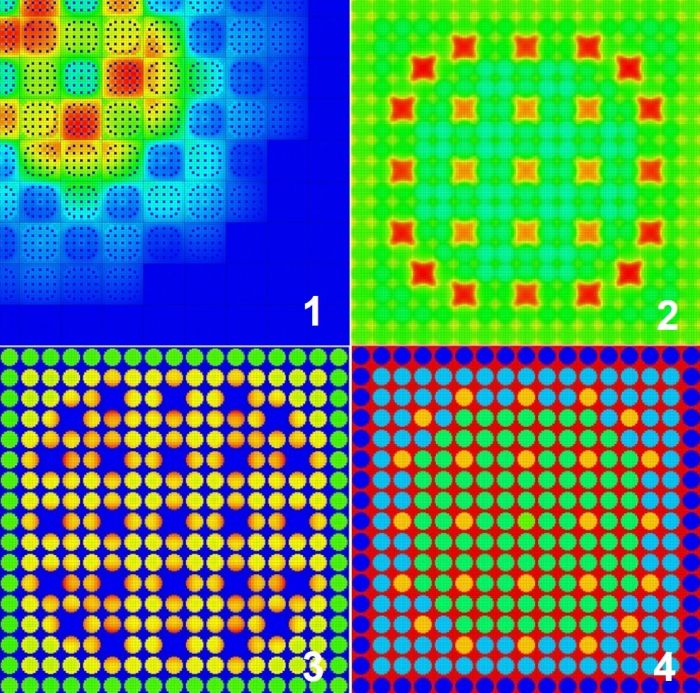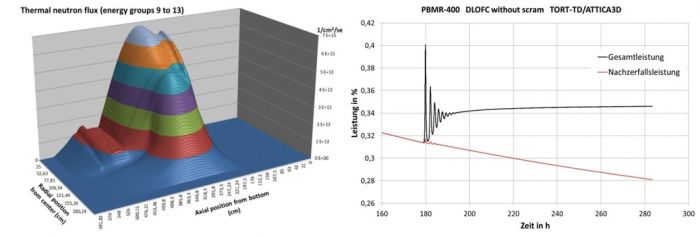TORT-TD: Transient 3-d Few-Group Neutron Transport Code for LWR and Gen-IV Safety Assessment
The time-dependent 3-d fine-mesh few-group discrete ordinates (SN) neutron transport code TORT-TD is developed for high-fidelity deterministic transient 3-d safety assessment of, e.g.,
- light water reactors (PWR, BWR),
- gas-cooled high temperature reactors (V/HTR) of pebble-bed type,
- accelerator-driven subcritical systems (ADS).
For thermal-hydraulic feedback, TORT-TD is coupled with the system code ATHLET, the subchannel code COBRA-TF/CTF and the porous medium code ATTICA3D. Whereas the code systems TORT-TD/ATHLET and, in particular, TORT-TD/CTF was originally developed for high-fidelity LWR simulations of both neutron kinetics and thermal-hydraulics phenomena, TORT-TD/ATTICA3D also aims at the analysis of 3-d high temperature reactors of pebble-bed type, subcritical systems driven by external neutron sources and research reactors. The features of TORT-TD include:
- Direct solution of the time-dependent 3-d SN transport equation for both Cartesian and cylindrical geometry employing unconditionally stable implicit time integration;
- Arbitrary number of prompt and delayed neutron precursor groups, arbitrary Legendre scattering (Pl) and SN order;
- Fully integrated 3-d fine-mesh few-group diffusion solver for fast running scoping calculations or as preconditioner for subsequent transport calculations or future embedded transport-diffusion analyses;
- Movements of individual control rods or control rod banks;
- Processing of tabulated cross section libraries for up to 6 state parameters with either linear or cubic spline polynomials interpolation;
- Generalized Equivalence Theory (GET) at pin cell level to reduce LWR homogenization errors;
- Time-dependent anisotropic distributed external neutron source capability;
- Leakage and buckling calculation over larger spatial regions, e.g. spectral zones;
- Calculation of Xenon/Iodine spatial dynamics as a prerequisite for operational transients;
- Decay heat calculation according to DIN standard 25485;
- Graphical pre- and post-processing for visualization of input data and output spatial distributions.
Within the applied internal coupling approach, the respective thermal-hydraulic code models the entire fluid dynamics and heat transfer processes in the primary circuit including the core region. The exchange of spatial distributions (power density and thermal-hydraulic state distributions) is managed by interface routines, e.g. the standard ATHLET interface. This allows maintaining each code individually whilst TORT-TD is linked to ATHLET in terms of a shared library.

Current areas of application: Use of TORT-TD/CTF for the safety assessment of local phenomena in BWR
Current work at GRS includes the further development of TORT-TD/CTF for the safety assessment of local phenomena as they can occur in complex modern boiling water reactor fuel element designs. The continuous optimization of the BWR fuel element types used, represented by, e.g., partial-length fuel rods, locally varying enrichment, burnable neutron poisons, leads to increasingly complicated flow conditions in the fuel assembly and to stronger radial and axial variations of power, fuel/cladding temperature and moderator density distributions.
The influence of neighboring fuel elements on neutron physics and thermo hydraulics of the fuel assembly under consideration as well as the thermal hydraulic boundary conditions also play a role. Due to its further developments, GRS is able to analytically model these complex phenomena and to simulate a possible occurrence of undesirable effects in the fuel such as local power density and fuel temperature increases, local dryout effects and, as a result, increased local cladding oxidation processes.
Based on stationary and transient simulations of representative mini-core arrangements, GRS carried out safety analyzes and gained information on safety-relevant local distributions of pin power, moderator void and fuel temperature.
